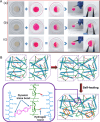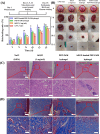Polysaccharide-Based Hydrogels for Advanced Biomedical Engineering Applications
- PMID: 39679058
- PMCID: PMC11638789
- DOI: 10.1021/acspolymersau.4c00028
Polysaccharide-Based Hydrogels for Advanced Biomedical Engineering Applications
Abstract
In recent years, numerous applications of hydrogels using polysaccharides have evolved, benefiting from their widespread availability, excellent biodegradability, biocompatibility, and nonpoisonous nature. These natural polymers are typically sourced from renewable materials or from manufacturing processes, contributing collaboratively to waste management and demonstrating the potential for enhanced and enduring sustainability. In the field of novel bioactive molecule carriers for biotherapeutics, natural polymers are attracting attention due to their inherent properties and adaptable chemical structures. These polymers offer versatile matrices with a range of architectures and mechanical properties, while retaining the bioactivity of incorporated biomolecules. However, conventional polysaccharide-based hydrogels suffer from inadequate mechanical toughness with large swelling properties, which prohibit their efficacy in real-world applications. This review offers insights into the latest advancements in the development of diverse polysaccharide-based hydrogels for biotherapeutic administrations, either standalone or in conjunction with other polymers or drug delivery systems, in the pharmaceutical and biomedical fields.
© 2024 The Authors. Published by American Chemical Society.
Conflict of interest statement
The authors declare no competing financial interest.
Figures










Similar articles
-
Recent Progress on Polysaccharide-Based Hydrogels for Controlled Delivery of Therapeutic Biomolecules.ACS Biomater Sci Eng. 2021 Sep 13;7(9):4102-4127. doi: 10.1021/acsbiomaterials.0c01784. Epub 2021 Jun 17. ACS Biomater Sci Eng. 2021. PMID: 34137581 Free PMC article. Review.
-
Marine-Derived Polysaccharide Hydrogels as Delivery Platforms for Natural Bioactive Compounds.Int J Mol Sci. 2025 Jan 17;26(2):764. doi: 10.3390/ijms26020764. Int J Mol Sci. 2025. PMID: 39859476 Free PMC article. Review.
-
Exploring the potential of polysaccharide-based hybrid hydrogel systems for their biomedical and therapeutic applications: A review.Int J Biol Macromol. 2024 Jan;256(Pt 1):128348. doi: 10.1016/j.ijbiomac.2023.128348. Epub 2023 Nov 24. Int J Biol Macromol. 2024. PMID: 38007021 Review.
-
Metal ion crosslinked polysaccharide hydrogels: A review on their potential for therapeutic delivery and tissue engineering.Int J Biol Macromol. 2025 May;310(Pt 3):143467. doi: 10.1016/j.ijbiomac.2025.143467. Epub 2025 Apr 23. Int J Biol Macromol. 2025. PMID: 40280517 Review.
-
A recent study of natural hydrogels: improving mechanical properties for biomedical applications.Biomed Mater. 2025 Mar 11;20(2). doi: 10.1088/1748-605X/adb2cd. Biomed Mater. 2025. PMID: 39908671 Review.
Cited by
-
Advances in cellulose-based hydrogels: tunable swelling dynamics and their versatile real-time applications.RSC Adv. 2025 Apr 14;15(15):11688-11729. doi: 10.1039/d5ra00521c. eCollection 2025 Apr 9. RSC Adv. 2025. PMID: 40236573 Free PMC article. Review.
-
Advances in Cellulose-Based Hydrogels: Current Trends and Challenges.Gels. 2024 Dec 20;10(12):842. doi: 10.3390/gels10120842. Gels. 2024. PMID: 39727599 Free PMC article. Review.
-
Toward Intelligent Materials with the Promise of Self-Healing Hydrogels in Flexible Devices.Polymers (Basel). 2025 Feb 19;17(4):542. doi: 10.3390/polym17040542. Polymers (Basel). 2025. PMID: 40006203 Free PMC article. Review.
-
Synthesis of PVA-Based Hydrogels for Biomedical Applications: Recent Trends and Advances.Gels. 2025 Jan 23;11(2):88. doi: 10.3390/gels11020088. Gels. 2025. PMID: 39996631 Free PMC article. Review.
-
Water Absorption Capacity and Agricultural Utility of Biopolymer-Based Hydrogels: A Systematic Review and Meta-Analysis.ACS Polym Au. 2025 Jun 11;5(4):325-342. doi: 10.1021/acspolymersau.5c00019. eCollection 2025 Aug 13. ACS Polym Au. 2025. PMID: 40821875 Free PMC article. Review.
References
-
- Shakil A. R.; Begum M. L.; Shaikh M. A. A.; Sultana S.; Rumon M. M. H.; Rahman M. S.; Roy C. K.; Haque M. A. Jute Fiber Reinforced Hydrogel Composite for Removal of Methylene Blue Dye from Water. Dhaka Univ. J. Sci. 2022, 70 (2), 59–64. 10.3329/dujs.v70i2.62608. - DOI
Publication types
LinkOut - more resources
Full Text Sources
